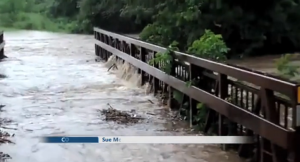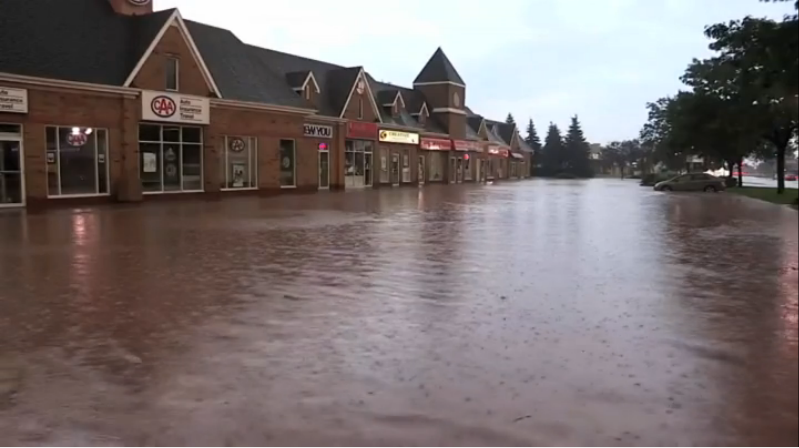 By Carol Gottlob
By Carol Gottlob
Candidate ward 4
October 12, 2014
BURLINGTON, ON.
Each week, until the ballots are cast on October 27th, we are going to follow the tales and travails of a single candidate. We have chosen Carol Gottlob, running in ward 4 against a well entrenched incumbent. Gottlob has no experience in civic government, has never campaigned before. Following this candidate is not an endorsement; Gottlob will win on her own merit.
Thanksgiving holiday marks the 10 week point since the flood hit Burlington on August 4th. In the final weeks of this year’s municipal election campaign, I find myself walking up to houses in all parts of Ward 4; some still have bins in the driveway, and many are patiently waiting for the contractors to show up.
The physical clean-up is virtually complete in terms of removing debris and cleansing, but the social and emotional rebuilding still has to happen and confidence in our government needs to be restored.

Creeks couldn’t handle the volume of water because they were left in a “naturalized” state which meant broken limbs and fallen branches were not regularly cleaned out
During this severe rain storm, our municipal systems that combine storm water and raw sewage into the same pipeline were exposed to more volume than they could handle, and the result was sewage backup spewing out into basements and other low lying drains. As we now know, sanitary sewer overflows which were caused by that huge downpour, created a severe problem to the environment, to public health and significantly, to many homeowners, wreaking havoc on many Burlington homes, causing thousands of dollars in damage to floors, walls, furniture, appliances and electrical systems.
This situation also threatened our Public Health because these overflows were comprised of raw sewage before it reached our waste water treatment plant, and it contained disease-causing bacteria, floating human waste, toxic pollutants, pesticides, and other contaminants that threaten public health and the environment, contaminate drinking water sources, and damage buildings.
Those unfortunate Ward 4 residents who found themselves in this terrible situation were not alone, we now realize. With heightened awareness, we are now learning that the increase in the number of homes connected to already aging sewage systems has contributed to rapid and repeated increases in sanitary sewer backups, flooded basements and overflows in our community.

The flood waters sparred no one – home owners and commercial sections of the city all had water in their premises.
In addition, the problems of the adversely affected Ward 4 homeowners were, in many instances, also negatively impacted by nearby creeks, such as Tuck Creek which became blocked by fallen trees and debris, consequently overflowing and further flooding many residential basements via windows and portals.
Generally, the creeks and waterways in Burlington are under the jurisdiction of Conservation Halton. The storm water system comprised of storm water sewers and culverts is under the jurisdiction of the City of Burlington. Sanitary sewers and waste treatment is under the jurisdiction of the Halton Regional Government.
The question before us is this; are these governments taking sufficient initiatives and offering appropriate financial and other assistance to the adversely affected homeowners?
Apparently, Burlington is making grants to affected citizens to offset the cost of building permits and Halton is offering a lump sum towards the cost of the installation of a back-flow valve.
In this regard, I must point out that it is unacceptable to me that our municipalities are also making it a condition of such nominal payments, that a homeowner formally release the municipality from any other claims they may have. The only statement that may, in my view, be required from any recipient is that such payments shall not be deemed an admission of liability by the government and that if a claim against the government is subsequently successful, the government shall be credited with the payment received.
In my view, this extraordinary, but rare, negative situation deserves an extraordinary response from our municipal governments. Provincial and community fundraising contributions notwithstanding, the municipalities should exercise their authority under the Municipal Act to make a financial grant to the affected homeowners and the municipalities would together, upon a formula agreed between them, fund such grants to compensate for the following:
a) the full cost of the purchase and installation of a sewer back-flow valve;
b) the cost of cleaning out and disposing of the sewer backup sludge, the damaged walls, floors and household contents;
c) the cost of removing mold, cleaning and restoring the basement walls, foundation and main floor where affected;
d) the cost of replacing the interior walls and floors of the basement and main floors damaged by the storm and sewer backup;
e) an interest free loan to cover the costs of restoring the basement and its contents, as well as the main floor where affected and not covered by the compensation listed above.
Certainly, the foregoing compensation would be subject to several process and claim procedures, including the homeowner being able to establish to the governments his or her losses and damages, as well as evidence that none of their claims were covered by private insurance coverage. Clearly, the governments would not be obliged nor able to compensate the homeowners for the loss of intangibles, computer data, electronic media and related records.
It may be argued by some, that the compensation outlined above for the affected homeowners is a precedent to be avoided and that, generally, it is too expensive to be paid for by the governments.
 My response is that such compensation to our neighbours is a precedent which should be set, as it is entirely in the public interest that the few citizens among us affected so adversely by such a storm should not have to bear alone and alone assume all of the negative costs of this storm due to the failure of our municipal infrastructure to handle such a storm. As one homeowner pointed out to me, if a municipal water main erupted and caused damage to nearby homes, would the municipality not be responsible?
My response is that such compensation to our neighbours is a precedent which should be set, as it is entirely in the public interest that the few citizens among us affected so adversely by such a storm should not have to bear alone and alone assume all of the negative costs of this storm due to the failure of our municipal infrastructure to handle such a storm. As one homeowner pointed out to me, if a municipal water main erupted and caused damage to nearby homes, would the municipality not be responsible?
How is this event any different, other than it being on a much larger scale? The responsibility still rests on the municipalities, and those homeowners who are experiencing repeated floods are no longer eligible for private insurance. Someone has to step up.

Carol Gottlob – running for the ward 4 council seat and a seat on the Regional government; two bikes, one car.
Furthermore, due to the fact that we can anticipate other significant storms in the future, these expenses are justified in so far as they will remove the public health threat to these citizens whose homes are vulnerable, without such improvements, to being subjected to subsequent sewer backups.
If the municipalities in the past refused to foresee the necessity to rebuild an infrastructure to handle such storms within the context of regional development, why shouldn’t they now assume the cost of paying the affected homeowners for the consequence of such prior government decisions?
All the more reason to learn from this and use the technology we have and the foresight we need to exercise, to plan and build for 100 years out if we want a stable and viable infrastructure and move away from costly damage control.
As the evenings close in on us and the weather turns cooler, I am thankful for the warmth emitted from my furnace, however I am sadly reminded that some of my neighbours are not so fortunate, through no fault of their own, and we owe it to them to provide the basic necessities through community assistance as well as good government that takes responsibility for those provisions.




















Carol Gottlob has TWO VOTES for City & Regional Councillor from this household.
The incumbent appears to be “in it for himself, and for personal gain.”
For instance … under the 2006 – 2010 regime at City & Region, we had to wait TWO YEARS, NINE MONTHS AND ELEVEN DAYS to have the turf restored to our boulevard. When called for assistance, the incumbent stated, “I am at a meeting” … with NO CALLBACK!
In the ICE STORM of last December, the Province distributed $180 Million to affected Regions and Municipalities. We’ve NEVER HAD any information or accounting for the amount Burlington received or what it was used for.
If an ICE STORM occurs AGAIN, we will ALL SEE EVIDENCE of how the City’s Tree Program ( or lack thereof ) has contributed to an anticipated EXTENDED Power Outage. The City is prepared to gamble lives with their Beech Tree Program.
Hail Carol and Hans Jacobs … Carol is a BREATH OF FRESH AIR … and Hans provides reasoned and well-thought opinion.
Re: “Generally, the creeks and waterways in Burlington are under the jurisdiction of Conservation Halton. The storm water system comprised of storm water sewers and culverts is under the jurisdiction of the City of Burlington. Sanitary sewers and waste treatment is under the jurisdiction of the Halton Regional Government.”…. I agree with Carol Gottlob, that these three organizations apparently failed to do what was needed to prevent this catastrophe.
It’s embarrassing to live in a city that appears to give higher priority to large legacy projects like a pier or performing arts centre over a well designed and maintained flood control system. At a minimum, the City should immediately do whatever it takes to disconnect the storm sewers from the sanitary sewers – what’s stopping that?